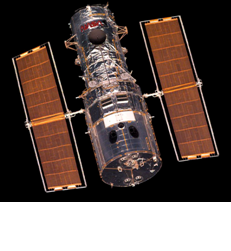- 1610: Galileo
- 1676: Ole Rømer
- 1687: Isaac Newton
- 1781: William Herschel
- 1838: Friedrich Bessel
- 1861: William and Margaret Huggins
- 1912: Henrietta Leavitt
- 1917 Einstein
- 1920: Harlow Shapley
- 1929 Edwin Hubble
- 1948: Ralph Alpher
- 1949: Fred Hoyle
- 1963: Maarten Schmidt
- 1964: Arno Penzias and Robert Wilson
- 1978: Vera Rubin and Kent Ford
- 1989: Margaret Geller and John Huchra
- 1992: John Mather and George Smoot
- 1995: Robert Williams
- 1998: Saul Perlmutter and Brian Schmidt
- 2010: Wendy Freedman
The Hubble Space Telescope
 Hubble’s primary mirror, at 2.4 meters (about 95 inches) in diameter, is not especially large as big telescopes go. The twin Keck telescopes have mirrors 10 meters in diameter. However, because it is far above Earth’s atmosphere, there are no distortions. As a result the Hubble Space Telescope can see detail equivalent to reading the date on a quarter one mile away.
Hubble’s primary mirror, at 2.4 meters (about 95 inches) in diameter, is not especially large as big telescopes go. The twin Keck telescopes have mirrors 10 meters in diameter. However, because it is far above Earth’s atmosphere, there are no distortions. As a result the Hubble Space Telescope can see detail equivalent to reading the date on a quarter one mile away.
Shortly after Hubble was launched it was discovered that the mirror, which was accurately ground to one part in 800,000, had a systematic flaw. So the first images were disappointing, although still better than could be achieved with Earthbound telescopes. However, optical engineers designed new lenses, sort of a new pair of “glasses” to correct the flaw, and Hubble became the most amazing instrument ever created for observing the birth, life, and death of stars and galaxies.